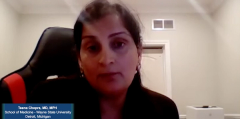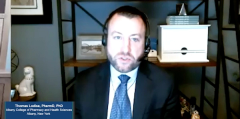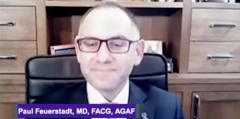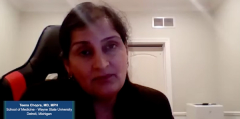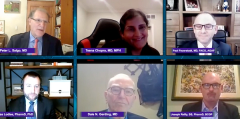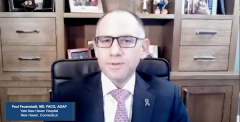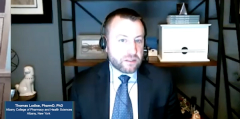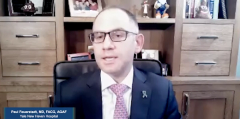
C. Difficile Risk Factors and Manifestation
Episodes in this series

Understanding the burden of C. difficile across the United States, panelists explore common risk factors associated with the condition and discuss the different ways it can manifest in patients.
Peter L. Salgo, MD: Hello, and welcome to this Pharmacy Times® Peer Exchange titled, “Expert Perspectives on Advances in the Management of Clostridioides difficile.” I am Peter Salgo from the Columbia University Irving Medical Center in New York, New York. Joining me in this discussion are Teena Chopra from Wayne State University School of Medicine in Detroit, Michigan; Paul Feuerstadt from the Yale New Haven Hospital in New Haven, Connecticut; Dale Gerding from the [Edward Hines Jr] Veterans Affairs Hospital in Chicago, Illinois; Thomas Lodise from the Albany College of Pharmacy and Health Sciences in Albany, New York; and Joseph Reilly from the AtlantiCare Regional Medical Center in Galloway, New Jersey. Our discussion is going to focus on the standard of care as well as some shifting paradigms in the management of initial and recurrent C diff infections. I want to welcome all of you. Let’s get started. Let’s ask the obvious and basic question: Why is C diff such an important issue? Who wants to start? Dr Chopra?
Teena Chopra, MD, MPH: Sure. C diff is a huge burden on the health care system, and it is the most important cause of hospital acquired diarrhea. Hence it’s very important that we think about the epidemiology of C diff and how it changes. It causes a huge economic burden and also is responsible for very high morbidity. On top of it I always consider C diff as a nuisance disease. I think it makes a patient more prone to recurrence, which is very debilitating for the patient. I’ve had patients who’ve had recurrent disease, and they’ve had to lose jobs because of the nuisance it causes with the diarrhea they experience. So this is a reason why C diff is a big issue.
Peter L. Salgo, MD: It sounds simple, right? And if you describe C diff to the public, they say, “It’s a diarrheal illness,” and they say, “So what, it’s diarrhea.” It’s not, and I see C diff all the time. Paul, you’re nodding. How do you explain the impact of this disease? It’s big.
Paul Feuerstadt, MD, FACG, AGAF: The impact is huge. In fact, in 2017 it was estimated that 365,200 Americans were affected with C difficile infection, which is a really remarkable number. You know, C difficile is an interesting organism. It’s a gram-positive spore forming anaerobic rod, and it works in a couple of ways. There 2 phases of the infection: The spore phase and the vegetative phase. And the vegetative phase is the phase that most of us think about when we think about C difficile infection, because that’s the phase that releases toxin A and toxin B to stimulate the diarrheal syndrome associated with it. But importantly, the spore phase is also a really essential phase because it is much hardier. It’s like a cocoon and protects the C difficile as it spreads from individual to individual. That’s the phase that really results in outbreaks of this infection.
Peter L. Salgo, MD: When my hospital, several years ago, switched over to putting Purell or other antimicrobial dispensers all over my ICU [intensive care unit], my concern was that people were going to use them in lieu of handwashing. The 1 takeaway for all the residents, nurses, and PAs [physician assistants] was that it doesn’t work on the spore phase. Does it, Paul?
Paul Feuerstadt, MD, FACG, AGAF: No, it doesn’t. In fact, that’s an excellent point. The spore phase is resistant to gastric acid and alcohol-based hand sanitizers like Purell. When we swallow the spore phase, it can get through our gastric acid, it gets to our small bowel. In the small bowel there’s a convergence to the vegetative phase, where the vegetative phase multiplies, divides, and multiplies some more. It really builds an army heading toward the colon. But I’m a gastroenterologist, and I think the colon is a brilliant organ. And the colon is a really smart organ because the colon has its own defense system independent of the blood-borne defense system that protects it. That defense system is colonization-resistance for the microbiota.
Peter L. Salgo, MD: We’ll get to that. But what are the main virulence factors? All C diff infections are bad, but are some worse than others? How do we know this? Who wants to tackle that? Paul, do you want to start?
Paul Feuerstadt, MD, FACG, AGAF: Sure. What are some risk factors? The risk factors I like to think about are 3-fold. I think about demographics, medication exposures, and environment. From a demographic standpoint: anybody over the age of 65 years old, female gender; any form of immune compromise: chronic kidney disease, HIV, inflammatory bowel disease, inflammatory bowel disease on a biologic; medications: antimicrobials are at the top of the list, proton pump inhibitors, histamine blockers; environmentally: people who live in skilled nursing facilities, people who spend significant amounts of time in the hospital. Those individuals are all at remarkably increased risk of C difficile.
Peter L. Salgo, MD: Right. I don’t want to skip over the virulence factors, if there are any differences, 1 C diff compared with another. You said there’s toxin A and toxin B. Do some C diff produce only A and some produce only B? Does every C diff produce all the toxins? Who wants to weigh in on that? Help me out.
Teena Chopra, MD, MPH: The toxigenic strains of C diff—you know in the 1990s we had the North American strain, and that 1 strain caused huge outbreaks in North America and Canada. This is the strain we are really worried about because it produces huge amounts, 10 to 16 times the amount of toxin A and toxin B, and also a binary toxin. So these toxigenic strains are more worrisome because they’re also responsible for outbreaks and huge transmission inside the hospital setting, and even in the community setting.
Peter L. Salgo, MD: If you enjoyed this content, you should subscribe. We have an e-newsletter, and you can receive upcoming Peer Exchanges and other great content in your in-box—that’s right, electronically. I’ll see you next time. I’m Dr Peter Salgo. Thanks again for watching.
Newsletter
Stay informed on drug updates, treatment guidelines, and pharmacy practice trends—subscribe to Pharmacy Times for weekly clinical insights.

